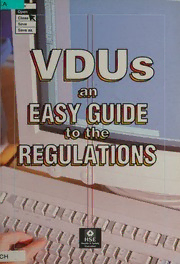
VDUs : an easy guide to the regulations : how to comply with the Health and Safety (Display Screen Equipment) Regulations 1992 PDF
Preview VDUs : an easy guide to the regulations : how to comply with the Health and Safety (Display Screen Equipment) Regulations 1992
Open Close Fe Save Save as HSE 7 a (-litimembey- 1-18 $477= |& “a unui WLDWS Gh GUIDE EASY fo tlie EUUAL ONES: How to comply with the Health and Safety (Display Screen Equipment) Regulations 1992 INFORMATION CENTRE 16 SEP 1994 WellCenctreo fomr Meedic al Science BOOKS (Oo VDUs AN EASY GUIDE © Crown Copyright 1994 Applications for reproduction should be made to HMSO First published 1994 ISBN 0 7176 0735 6 THE REGULATIONS SSS CT] CONTENTS Introduction 7 Deciding responsibilities 3 The steps to take 4 An assessment checklist 14 Further publications and sources of advice 18 (Oo VDUs AN EASY GUIDE THE REGULATIONS = ee | INTRODUCTION This booklet is for employers who need to comply with the Health and Safety (Display Screen Equipment) Regulations 1992. You may know them as the ‘VDU Regulations’ or ‘Display Screen Regulations.’ It is a practical guide, with easy to follow steps on what to do if you have standard office VDUs (visual display units). If you have equipment other than office type VDUs which you think may be covered, of ify ou want more information, you should refer to the full Regulations and HSE’s detailed guidance (see page 18). The Regulations put into UK law a European Community Directive which seeks to protect the health of your workers by reducing risks from VDU work. The health problems associated with this type of work are: Q) upper limb disorders (including pains in the neck, arms, elbows, wrists, hands, fingers); (J temporary eyestrain (but not eye damage) and headaches; Q) fatigue and stress. The causes may not always be obvious and can be a combination of factors. But enough is known about the importance of some measures - for example, the need to sit properly - to allow the risks to be tackled effectively. The Regulations came into force on 1 January 1993 and most of the requirements have to be complied with straightaway. If you haven't already, you should be taking steps to comply now. This booklet is colour coded. The blue areas explain the basic steps that need to be taken to comply with the Regulations. The red areas that follow give more detailed help on each of the steps. A checklist you can use to assess workstations and to help make sure they comply with the Schedule to the Regulations is at the back. It gives solutions to some common problems. Some of the advice in this guide takes the form of suggestions on how to comply. Where these are steps not actually required by law, this is made clear, eg: Q “You may want to set a timetable” Q) “Consider using videos” U “Checklists are one way to do assessments” 4 “These guidelines may be helpful” 4 “The following points may help” VDUs AN EASY GUIDE THE REGULATIONS | DECIDE FIRST WHO IS TO BE RESPONSIBLE FOR: Identifying which people and workstations are covered Training users and assessors 7ES ee Keeping users informed Make sure whoever you choose (it may be more than one person) agrees their responsibilities and knows what is expected of them. Make this booklet required reading. Check later that action has been taken. You may want to set a timetable for action. DON’T ASSUME YOU NEED CONSULTANTS TO HELP YOU COMPLY. YOU WILL PROBABLY NEED OUTSIDE HELP FOR EYE TESTING AND ANY INVESTIGATIONS OF SERIOUS ACHES AND PAINS. BUT SIMPLE PROBLEMS DON’T REQUIRE SPECIALIST EXPERTISE. Ez VDUs AN EASY GUIDE DECIDE WHO IS COVERED BY THE REGULATIONS AND IDENTIFY THE WORKSTATIONS THEY USE Not everyone who uses a VDU is covered by the Regulations - only those most likely to be at risk. You need to decide who these people are. Remember to include homeworkers when deciding. TELE HELP People using a VDU more or less continuously on most days will be in’. So, normally, are others who: L) normally use a VDU for continuous spells of an hour or more vteaeaenr e at atime; and LJ use it in this way more or less daily; and eee LU) have to transfer information quickly to or from the screen; and also need to apply high levels of attention or concentration; or are highly dependent on VDUs or have little choice about using them; or need special training or skills to use the equipment. Such people are called users in this booklet. (The Regulations distinguish between employees - users and self-employed workers - operators. This distinction is not used here - where certain obligations do not apply to the self-employed, this is made clear in the text.)
